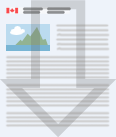
Description of infographic: How to Keep Food Safe: Categories of Hazards
Keeping food safe
The following are considered to be international best practices to identify food hazards. A hazard is anything present in food with the potential to harm someone, either by causing illness or injury.
Biological Hazards:
Bacteria, viruses, or parasites that could cause foodborne illness
Watch out for:
- Staff with poor hygiene or food handling techniques
- Bacteria commonly found in food
- Storing or preparing food at a temperature that allows bacteria to grow
- Ingredients that have spoiled
Protect your food by:
- Rotating stock
- Storing and preparing food at proper temperatures
- Practicing good hygiene in your facilities
Chemical Hazards:
Anything that could introduce an unwanted chemical into your food
Watch out for:
- Food in contact with cleaning chemicals
- Unintentional contact with common food allergens, such as peanuts or seafood
- Improper use of food additives during preparation
Protect your food by:
- Labelling and storing chemicals separately from food
- Using correct cleaning and preparation procedures
Physical Hazards:
Unintentional or dangerous materials that could end up in your food
Watch out for:
- Personal objects, such as jewellery, that may fall into the food
- Materials that do not belong in some food, such as bone chips, leaves, shells and pits
Protect your food by:
- Conducting regular visual inspections
- Following appropriate procedures in your facility
By preventing food safety hazards, you:
- Reduce the likelihood of foodborne illness and recalls
- Protect your business and reputation
Did you know?
Food can become contaminated during growing, harvesting, processing, shipping, storing or handling.
